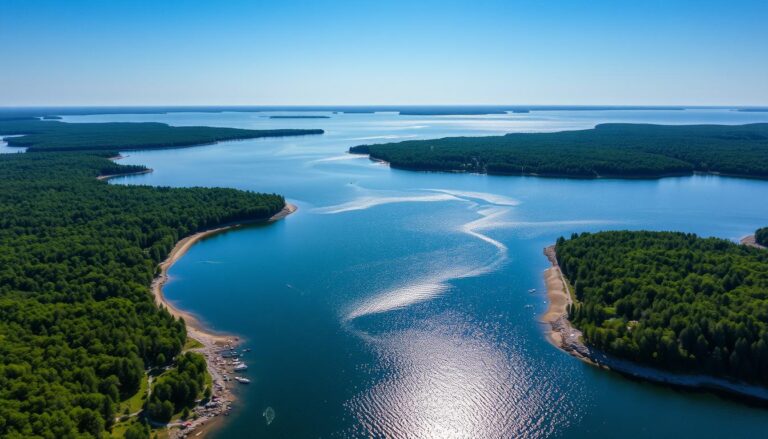Nestled in northwestern Russia, Lake Ladoga stands as the largest lake in Europe, offering a breathtaking blend of natural beauty and historical significance. This awe-inspiring freshwater giant spans the regions of Leningrad Oblast and the Republic of Karelia, lying just about 40 kilometres east of the vibrant city of Saint Petersburg. If you’re a geography enthusiast or merely someone who cherishes Europe’s natural wonders, Lake Ladoga is a worthy addition to your list.
Lake Ladoga not only holds the prestigious title of being Russia’s largest lake but is also a gem among European lakes. Its enormous surface area of 17,891 square kilometres makes it the second largest lake in Russia, right after Lake Baikal. And if that’s not impressive enough, it’s the fourteenth largest freshwater lake in the world by area. So, you’re certainly looking at one of the most significant bodies of water globally.
Exploring the geography of Lake Ladoga, you’ll find a captivating mix of natural features that contribute to its grandeur. The lake’s maximum depth ranges between 230 and 260 metres, making it sufficiently profound to support diverse aquatic life. The intriguing aspects of Lake Ladoga go beyond its size and depth. It hosts approximately 660 islands, with Valaam Island being one of the notable ones, scattered mainly in the northwestern region of the lake. These islands not only add to the captivating scenery but also present unique ecosystems and habitats.
For centuries, Lake Ladoga has played a pivotal role beyond its geographical importance. The lake has been a linchpin in historical trade routes and wartime activities, cementing its status as a significant landmark in European history. During the Siege of Leningrad in World War II, Lake Ladoga was a vital lifeline for the city, providing an escape route and supply path through the infamous “Road of Life.” Such historical anecdotes only add to the layered cultural and historical fabric that Lake Ladoga offers to explorers and scholars alike.
Moreover, this natural marvel is crucial to the European ecosystem. The lake’s abundant waters support an impressive range of flora and fauna. From diverse fish species like roach, zander, and European perch to the unique Ladoga seal subspecies, the lake’s biodiversity is nothing short of extraordinary. This richness in life underlines Lake Ladoga’s role in maintaining ecological balance and serving as a key reservoir of genetic diversity in the region.
In addition to its ecological and historical importance, Lake Ladoga offers numerous recreational opportunities, from fishing to sightseeing, making it a cherished destination for nature lovers. Whether you’re keen on engaging with the historical narratives or simply basking in the tranquil beauty, Lake Ladoga has something for everyone.
So, if you ever find yourself yearning for an escape to a place where nature and history coalesce in the grandest of fashions, Lake Ladoga awaits with its sprawling waters and rich legacy. Discover for yourself why this incredible lake continues to hold such an esteemed place among Europe’s famous lakes.
Geography and Physical Characteristics of Lake Ladoga
When looking at the geography of Russia, Lake Ladoga stands out as a crown jewel among the natural wonders of Europe. This magnificent lake is a key feature, with its vast expanse and unique ecosystem.
Location and Coordinates
Situated between 59°54’N and 61°47’N latitude, and 29°47’E to 32°58’E longitude, the Lake Ladoga location is a central element in the geography of Russia. At an elevation of 4.8 meters above sea level, this freshwater expanse covers an impressive surface area. With coordinates of 61°00′N 31°30′E, Lake Ladoga serves as a substantial reservoir contributing to the Neva River.
Size and Depth
Ladoga’s size and features are truly remarkable. Spanning approximately 17,891 km², excluding its islands, this colossal body of water extends up to 219 km in length and 138 km at its widest point. The lake’s average depth is 167 feet, with the deepest point reaching an astounding 754 feet west of Valaam Island. This voluminous capacity makes Lake Ladoga not only the largest lake in Europe but also a critical natural resource.
Islands and Surrounding Terrain
A fascinating aspect of Lake Ladoga is the presence of around 660 islands covering a total area of 435 square kilometres. The terrain surrounding the lake is diverse, rich with forests, peat-bogs, and agricultural land. Valaam Island stands out among these, renowned for its scenic beauty and historic significance. This varied terrain supports numerous species, making Lake Ladoga a vital part of Europe’s natural wonders.
Together, these elements—the lake’s coordinates, size, depth, and surrounding landscape—paint a picture of a significant geographical marvel within the geography of Russia. Lake Ladoga’s location and unique features undeniably enhance its standing as both a natural wonder and a crucial ecological and economic resource.
What is the Largest Lake in Europe
Lake Ladoga proudly holds the title of being the largest lake in Europe. Situated in northwestern Russia, it surpasses all other freshwater lakes in Europe in both size and depth. Boasting a staggering surface area of 17,703 square kilometers, Lake Ladoga is not only a geographical marvel but also a focal point in the exploration of Lake Ladoga’s historical and ecological significance.
Comparison with Other European Lakes
When comparing Lake Ladoga with other prominent European lakes, its enormity becomes even more evident. The second-largest, Lake Onega, also in Russia, covers 9,894 square kilometers – nearly half the size of Lake Ladoga. Notable mentions include Lake Vänern in Sweden (5,655 square kilometers), and Lake Saimaa in Finland (4,377 square kilometers). Lake Peipus, shared between Estonia and Russia, spans 3,555 square kilometers. These comparisons underscore Lake Ladoga’s unparalleled size among freshwater lakes in Europe, accentuating its importance as a natural wonder.
Historical Significance
The historical significance of Lake Ladoga is equally remarkable. During the Viking Age, it was part of the trade route from the Varangians to the Greeks, facilitating early connections between Northern Europe and the Byzantine Empire. Most notably, during World War II, Lake Ladoga served as a critical lifeline during the Siege of Leningrad. Known as the “Road of Life,” it provided a crucial route for supplies and evacuations, playing a vital role in the survival of the city’s residents.
The Role of Lake Ladoga in European Ecosystem
Lake Ladoga’s ecosystem is a vital component of the larger European lake ecosystems. Its vast and diverse habitats support an array of unique species, including the endemic Ladoga seal. Fisheries prosper in its waters, bolstering local economies and providing sustenance for surrounding communities. Additionally, the lake serves as an essential rest stop for migratory birds, further enhancing its role in sustaining biodiversity. The ecological health of Lake Ladoga is integral to the overall well-being of both regional and broader European ecosystems, emphasising the need for continued conservation efforts.

